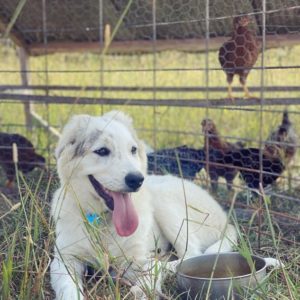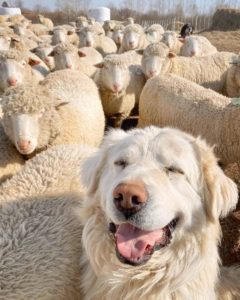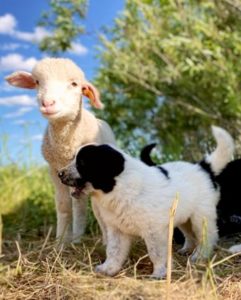What Makes a Good Livestock Guardian Dog?
Surrounded by the pine trees of Finlayson in northern Minnesota, Hannah Bernhardt of Medicine Creek Farm has had livestock guardian dogs (LGDs) since she started the farm in 2016. Besides the more typical coyote pressure, Hannah also deals with roaming wolf packs that move through the area. Yet in the last nine years, she’s never lost a sheep to predators. Her LGDs are indispensable.
But what makes a good livestock guardian dog? Hannah has a few guidelines.
Breed and Personality
First, at the most basic level, it comes down to the individual dog. “It’s almost 100% personality,” Hannah says unequivocally. Even in a litter of proven LGDs, there may be some pups that just aren’t suited to be working dogs. They just don’t have the demeanor for the work.
Even among dogs with potential, you likely won’t have a universal LGD. A dog that is good with small ruminants may not work with poultry, and vice versa. “Some dogs just are chicken dogs. Some just don’t have it.” The difference is assertiveness versus submissiveness.
To be good with chickens, Hannah says that a submissive dog is key. In general, that submissive quality helps the dog bond with any species it’s protecting. Though, if predator pressure is particularly high, a more assertive dog can be worth the tradeoff.
While personality can be a luck of the draw, a given breed will make certain traits more likely. For instance, according to Hannah, Great Pyrenees tend to bond well with chickens – but “because they’re patrollers, they make terrible chicken dogs.” Originally bred to roam for miles protecting sheep in the high mountains, they simply won’t stay put with a flock of chickens.
Whereas breeds, like the Spanish Mastiff, that worked with dairy sheep don’t wander as far because dairy sheep had to remain nearby for daily milking.
Hannah appreciates the friendly traits that the Central Asian Shepherd breed brings to her dogs. They are more sociable and accepting of people, which she attributes to their history of traveling with nomadic groups.
On some farms, a wariness around unknown people might be valued, but Hannah has events and guests as part of her agritourism enterprise. Having dogs that will quickly acclimate to new people and won’t incessantly bark at strangers is important.
The Context
You might need more than one dog. Hannah says that if you don’t have any predator pressure yet, one dog may work as a preventative measure. “But if you have any sort of predation, you really need two. And if you’ve got wolves, you need at least four.”
When dealing with predators, Hannah also advises against killing coyotes. Let them get accustomed to a new LGD. “The coyotes you have now are the ones you probably want to keep.” Eradicating a pack will leave a void that a new group will inevitably fill.
Those new coyotes won’t understand the role of the LGD, and it will take conflict to reestablish a stable dynamic, which could be worse than what you’re dealing with now. Plus, if female coyotes recognize local population numbers dwindling, they will have larger litters.
Studies out West have shown that coyote eradication efforts can actually lead to stronger populations. “We’re learning to live alongside the predators as opposed to trying to eliminate them.”
Additionally, Hannah says that dogs can only work in the right situation. Active engagement and monitoring, along with the smaller spaces allotted in a rotational grazing system, are key. “You can’t expect a dog to protect 160 acres on their own. There’s a mindset of some of the farmers around here to continuously graze, and if there’s a wolf problem, they’ll get a dog – but it doesn’t work. It’s about context.”
Training
The keystone in all of this is training. “When people get a new puppy, it’s the first two years – as a puppy and a teenager – when people have the most problems.” Teenagers test boundaries, both physical and behavioral. Especially if it’s your first time with a LGD, those years, while everything is new, will be the hardest and unfortunately the easiest to ruin the dog. Training opportunities abound, but so do the chances of missed opportunities or bad lessons.
Hannah also finds that people often don’t have enough patience with their dog. Even the best chicken guardian will kill a few chickens as they learn the job, or roughhouse with a lamb. These are times to teach, not inherently disqualifying incidents.
Livestock guardian dogs are an investment, both in money but also time. They require patience, commitment, but also a willingness to accept that failure is sometimes an option. But for many, the return a successful LGD brings to the farm is worth it.



